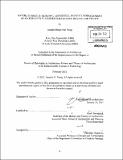Nature's objects : geology, aesthetics, and the understanding of materiality in eighteenth-century Britain and France
Author(s)
Ferng, Jennifer Hsiao-Mei
DownloadFull printable version (62.55Mb)
Other Contributors
Massachusetts Institute of Technology. Dept. of Architecture.
Advisor
Mark Jarzombek.
Terms of use
Metadata
Show full item recordAbstract
Explorations of aesthetic design and scientific experimentation have traditionally relied upon the natural world as a source of inspiration. Notably absent from previous studies of the eighteenth century is the dynamic connections between contrasting disciplines of this time period. Terrestrial objects such as diamonds, silver, gold, and stone, situated between architecture, the decorative arts, and geology, superseded classical models of Aristotelian emulation, which privileged original visual forms. They evoked newfound tensions between modalities of intuition and empirical observation, providing alternate paradigms of nature based upon firsthand experience. This dissertation takes up an extensive assembly of historical actors who analyzed these objects - architects, artisans, chemists, collectors, engravers, geologists, jewelers, and silversmiths. Late Enlightenment designers Robert Adam, William Chambers, and Batty Langley as well as intellectuals Denis Diderot and Louis Dutens explored some of the same materials that piqued the curiosity of silversmiths Pierre-Simon Augustin Dupre, Francois-Thomas Germain, and Jacques Roettiers. Artisan Pierre de Fontanieu and chemists Antoine Laurent de Lavoisier and Jean-Louis Baptiste Rome de l'Isle also problematized the aesthetic usages of these objects, arriving at differing conclusions. Pervasive debates throughout Europe attempted to determine the quotient of hardness in minerals, plasticity of metal, or durability of stone. These provocative cross-currents between the domains of the arts, sciences, and politics generated remarkable insight into these objects taken from the earth; in turn, these intersections shaped a unique conception of materiality, which anticipated untapped potential for architectural styles, artistic production, and geological determination. Mining and related images of the subterranean - mineralogical atlases, etchings of rock formations, maps of sedimentary deposits, imagined grottos, and utopian architecture - are framed as part of a geological imaginary, a contributor to modernism's early inheritance. The first chapter contemplates how the cutting of diamonds as raw stones cultivated attitudes towards jewelry settings, formulas for false gemstones, and chemical demonstrations. Artisans judged a diamond's functional and authentic attributes in order to craft acceptable imitations. In focusing upon silver and gold, the second chapter traces the material transformations of valuable metals from decorative ornament into commemorative coins and medals during the French Revolution. Fiscal currency circulated as economic signifiers that embodied human values superimposed onto natural resources. The third chapter examines several types of stone from limestone, granite, to marble demonstrating how their visual and structural properties became articulated through Gothic revival practices in Georgian England. Antiquarian and genealogical discourses not only influenced conceptions of stone as a building material, but they also focused upon geological explanations as a mutual foundation of comprehension. The conclusion merges the mythological stories behind these objects with their historical narratives, elucidating why cultural misinterpretations are as important as factual evidence. Derived from corporeal perception and abstract theorization, materiality revealed unknown dimensions of these prosaic objects, whose telluric origins became recast as both ancient and modem.
Description
Thesis (Ph. D.)--Massachusetts Institute of Technology, Dept. of Architecture, 2012. Cataloged from PDF version of thesis. Includes bibliographical references (p. 353-390).
Date issued
2012Department
Massachusetts Institute of Technology. Department of ArchitecturePublisher
Massachusetts Institute of Technology
Keywords
Architecture.